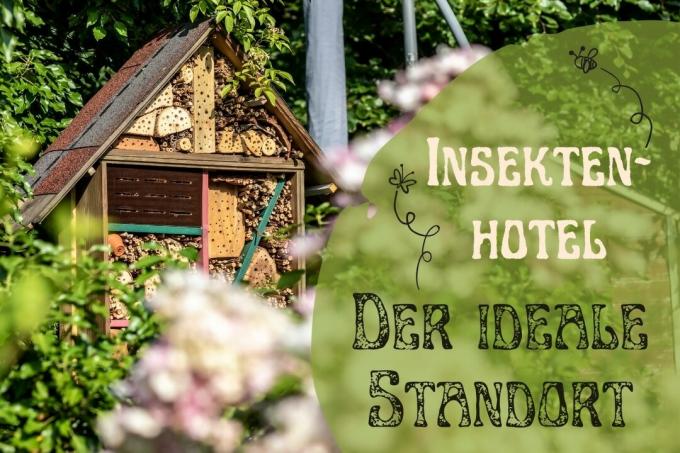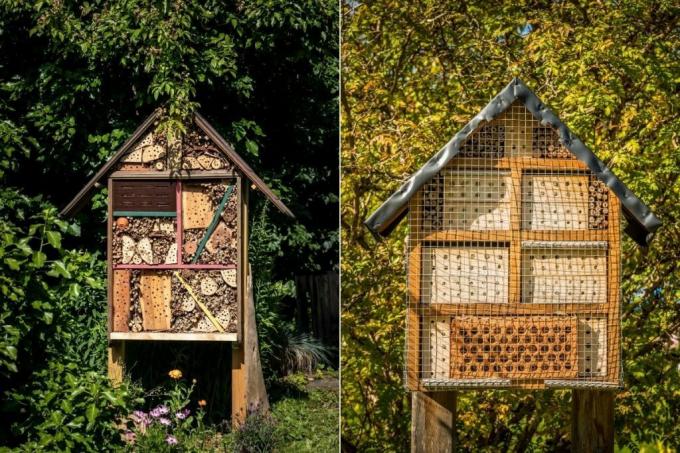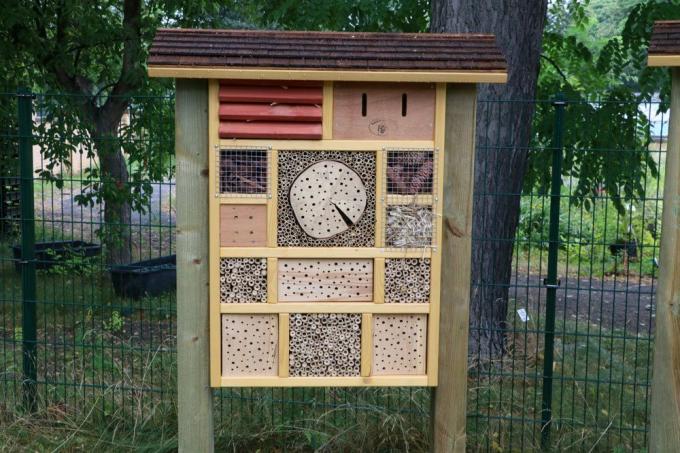
table of contents
- Attract insects
- Choose a sunny location
- Set up higher
- Create a food base
- No more relocation
- frequently asked Questions
An insect hotel attracts many beneficial insects into the garden. Wild bees, ladybugs and the like are very grateful for warm quarters. However, there are a few things to consider when setting up your insect hotel. The location is crucial.
In a nutshell
- Insect hotel is a helpful measure in nature conservation
- The location decides on the billeting of earwigs, wild bees and ladybirds, for example
- Orientation of the insect hotel to the south is important
- Set up / hang up the insect hotel at a height of at least 50 cm
- A good supply of food in the immediate vicinity is also necessary
Attract insects
An insect hotel not only makes an active contribution to nature conservation, but also lures useful insects into the garden. These can be helpful in pollinating plants and also in pest control. The offered accommodation is not only used by the hard-working helpers for wintering, but primarily as a nesting place. Set up correctly, you can then
- Lacewing
- Ladybug
- Catchy tunes
- Butterflies
- Wild bees
be attracted. However, when setting up an insect hotel you have to pay attention to a few things, otherwise it can happen that there are no guests.

Note: When setting up an insect hotel, only natural materials such as straw, wood wool, pine cones, bamboo tubes, plant stems and drilled round wood should be used. Different filling materials also attract different insects.
Choose a sunny location
The location not only determines its value in real estate, it is also important in an insect hotel. Insects love warmth. They are then more active and warmth is also necessary for the brood and later the development of the larvae. Therefore, the choice for the location of the insect hotel should also be made very carefully. He should
- Offer protection from wind, cold and moisture
- be full sun
- Sun all day if possible
- always face south
A sunny location has many advantages that are crucial for the settlement of the insect hotel and for the well-being of the insects:
- Heating up the Natural materials in the hotel
- Sun prevents fungal attack and rot in natural materials
- Quick drying guaranteed after rain
- no cooling down too quickly in winter

Insect hotels should never face north-west. In the local latitudes, this is the weather side. Mostly wind and rain come from here. There is a possibility that when it rains for a long time, filling materials such as wood wool, straw or pine cones and also the eggs of wild bees begin to go moldy. Furthermore, the approach path for the insects is made more difficult. This should normally always lead along the side of the insect hotel facing away from the weather. In this way, the insects can fly to their roost without any problems.
Note: You should always set up insect hotels so that they are clearly visible, so you can easily attract insects.
Set up higher
The insect hotels should not be set up directly on the floor, but slightly elevated. You should also pay attention to weight and size. A distance of 50 to 100 cm to the floor must be maintained. Direct contact with the ground has several disadvantages:
- Decomposition of the hotel by soil moisture
- Plants such as creepers can block access
- Pets and children come into contact with insects
- Damage on both sides is possible as a result
You should also tip the hotel slightly forward when setting up. This allows any water that occurs to run off again quickly and the nesting sites remain dry.

Create a food base
Not only the location, but also the food supply must be taken into account when setting up insect hotels. Sufficient food plants for the insects should always be available near the accommodation. The ways to these should be quite short, no longer than 300 meters. Most insects do extensive brood care and this is where the short distances come in handy. Good food crops include:
- Fruit trees
- Roses
- Wild mallow
- Columbine
- Summer flowers
- lilac
- elder
- clover
- Meadow sage and other herbs
In addition, a mobile raised bed with suitable planting can also do a good job. In addition to food, a wide variety of insects also need water to lay their eggs and, finally, sand and clay to close their hiding places. If possible, these materials should also be located near the hotels. Alternatively, can help
- setting up bowls of damp sand and clay
- Bird baths
- Rain barrels
- Use corks as a buoyancy aid
No more relocation
Once you have set up the hotel for insects, you should not change its location afterwards. Otherwise the following problems can occur:
- Insects can no longer find their home
- familiar sources of food are no longer accessible
- Insects are driven from their normal habitat
Note: You can set up insect hotels all year round. March is a good time, when the first guests are already moving in.
frequently asked Questions
Yes, there are no problems. As a rule, the insects do not pose a threat to humans. Only wild bee stings can be dangerous for allergy sufferers. However, the bees have to be provoked to do so. An appropriate distance from the house and terrace should therefore be maintained. Proximity to people is helpful in warding off natural predators such as birds.
Yes of course. However, care should always be taken to ensure that the hotel is in full sun. Sun all day would be ideal. Furthermore, appropriate food sources must then be created. This can be done by planting pots, tubs and window boxes with summer flowers. Alternatively, a raised bed can be set up with flowering plants if possible.
No, normally no additional protective measures such as covering in winter are necessary. In no case should the hotel be brought into the house. This can quickly disrupt the biorhythm of the insects. Due to the rise in temperature, they wake up prematurely from hibernation. In the absence of food, they would quickly starve to death. The prematurely hatching bee larvae would also be doomed to die.



